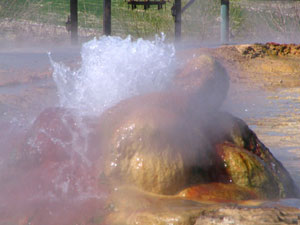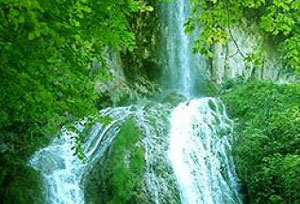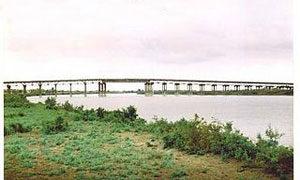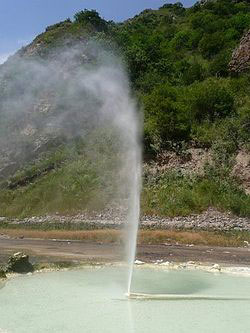Home page
» GEOGRAPHY
» Physical Geography
» Our useful waters
Our useful watersThermal waters  Scientific and practical investigations related to solution of the problems of using untraditional energy of the sun, wind and underground thermal waters are carried out in many developed countries of the world. Having heat energy accumulating and high heat intensive energy capacity properties of thermal waters are characterized as energy carrier of special important energy among sources of traditional energy. Geological-exploring works for study of thermal waters in Talysh zone (in regions of Astara, Lankaran and Masally) of Azerbaijan in the 1964-1970 years. So 17 exploring wells were drilled for these purposes and in all of them thermal waters with temperature of 38-64°C waters were found. 10 greenhouses were set in the winter months for using them as energy source to grow early vegetables (tomato, cucumber) and it was defined that there was possibility to get harvest 2-3 times within a year. Thermal waters were found at oil exploring wells with depth of 3200-4500 m in Jarly structures and their total output was 2500 m3 and temperature on surface was 72-97°C. With exploring wells at Caspian (Khudat-Khachmaz) zone with depth of 3000 m thermal waters with total output of over 30000 m3/day and with surface temperature of 50-81°C were found. In spite of wide spreading of thermal waters in territory of republic using them in various fields of economy is unsatisfactory. At present geological–exploring wells once drilled for thermal waters now are partly used in Khachmaz region for curing and household services. Prognosis of the exploitation stocks of thermal waters of the republic are estimated as the following: • South slope of the Greater Caucasus, 2000 m3/day (t-30-50°C); • The Absheron peninsula - 20000 m3/day (t-40-90°C); • Upland part of the Small Caucasus, 4000-5000 m3/day (t-30-74°C); • Nakhichivan Autonomous Republic - 3000 m3/day (t-40-50°C); • Lankaran plain - 7000-8000 m3/day (t-44-64°C); • The Kur depression- 170000 m3/day(t-30-71°C); • On republic - 249000 m3/day. At present special researches are conducted by the National Geological Exploring Service with purposes of determining usage directions of thermal waters found in the republic territory. Mineral waters  The mineral water fields having a specific place in health of population with its curative importance were grouped in 200 groups and more than 1000 natural exits of them were found. But only in 30 mineral group of water the geological-exploring works were completed and its exploitation reserves have been affirmed. Very valuable mineral waters, especially, have spread in the territory of Nakhichivan Autonomous Republic widely. There is not a coincidence that Nakhchivan is named as natural museum of mineral waters”. It is possible find the analogue of the majority of the mineral waters being known in the world. As curative-drinkable water in autonomous republic the reserves of mineral waters was affirmed in Shabuz region- Badamly (Narzan type), daily 690 thousand liters, in Babek region- Sirab (Borjomi type)- 178 thousand liters per day and Narzan type – 1468 thousand liter, in Vaykhir (Paytigorsk type) – 270 thousand liters per day, as balneology waters in the territory of the autonomous republic 4507 thousand liters of water of Minegorsk type was affirmed in Darydagh. But exploitation and prognosis reserves of mineral water stocks in Nakhichivan Autonomous Republic is much higher than these figures. The exploitation reserves of Upper Istisu waters in Kelbajar region, the analogue of famous Karlovi Vari mineral waters makes daily 82 thousand liters, Lower Istisu 260 thousand litres and Goturlu- 70 thousand liters, Tutday - 600 thousand litres. Sanatorium-resort complex, mineral water plant was functioned here on the base of these mineral waters in the past. The exploitation and prognosis of the mineral waters of the Kalbajar region is much higher than figures shown above. Unfortunately, at present Armenia had organized the export of these mineral waters from Kalbajar to foreign countries breaking all international laws in enormous scale. Analogue of the Naftusiya mineral water Qalaalti mineral water field in Davachi region have been affirmed to have exploitation reserves of 154 thousand litres volumes per day. Thermal waters of Nabran (29.9 thousand l/day reserves) in Khachmaz, Chukhuryurd (140 thousand l/day), Chagan (252 thousand l/day) in Shamakhy, Ilisu (284 thousand l/day) in Gakh region, Meshasu (550 thousand l/day), İbadsu (550 thousand l/day) in Shamakhy are used in the cure of many illnesses (dermatovenerologic, cardiovascular system etc). In Absheron peninsula Surakhani mineral waters (exploitation reserves 510 thousand l/day), Mardakan (620 thousand l/day), Buzovna (80 thousand l/day), Bilgah (280 thousand l/day) Pirshagi (35 thousand l/day), Shykhov (150 thousand l/day) are considered as perspective for wide usage. Exploitation reserves of the Buludul mineral waters in Lerik region are valued as 86.4 thousand l/day, in Gazakh, Salahli - 10.8 thousand l/day, Ashagy Salahli- 21.6 thousand l/day/, Askipara - 5.4 thousand l/day, Azizbayli - 2.7 thousand l/day, Shamlig in Tovuz region - 2.7 thousand l/day, Kazimli -10.8 thousand l/day, Kandalar - 43 thousand l/day, Shinikh - 8064 thousand l/day, Gyzylja in Gadabay region- 86.4 thousand l/day, Slavyanka - 21.6 thousand l/day, Qalakan - 108 thousand l/day, Chayqarishighy - 216 thousand l/day, Shamkir - 43.2 thousand l/day, in Dashkesan region, Yukhari Dashkesen- 4.3 thousand l/day, Ashagy Dashkesen- 5.4 thousand l/day, Alakhanchalli -108 thousand l/day, Qabiqtala -4.3 thousand l/day. Specialists note that the exploitation reserves of these of the waters in fact, are higher many times. Industrially important waters  Iodine-bromine water resources with affirmed industrial y reserves were exploited and have played a great role in republic economy during many years. General industry reserves of 5 iodine-bromine water fields on republic (Khilly, Babazanan, Mishovdagh, Bina--Hovsan and Neftchala) is 229.5 thousand m3/day, including 47.7 thousand m3/day on Khilly field, 50.1 thousand m3/day in Babazana field, 28.5 thousand m3/day in Mishovdagh field, 51.2 thousand m3/day in Bina-Hovsan field, 52 thousand m3/day in Neftchala field. Bina-Hovsan and Neftchala fields have not been exploited till 1995. The layer waters of the fields have 40 mg/l iodine, about 60-80 mg/l of bromine and other chemical components. Underground waters  In order to eliminate the serious problems in water supply of the population, first of all limitations in development of agriculture, due to reasons of unequal distribution of water resources of Azerbaijan, limited resources, the hydro-geological researches were conducted mainly in definition of underground water’s resources, usage opportunities of these resources. In order to do exploring of underground waters, calculation of resources and definition of usage opportunities the wide range geological–exploring works had been carried out in plain and foothills regions in view of requirements of state standards and normative related to suitable accumulation of underground waters. During various years the exploring of underground waters for purposes of water supply to residential settlements of Nakhchivan, Ganja, Khankandi, Yevlakh, Ujar, Aghdash, Goychay, Gazakh, Tovuz, Shamkir, Guba, Gusar, Khachmaz, Aghdam, Shamakhy, Beylagan, Imishli, Fuzuli, Zangilan, Jabrail, Aghsu, Shusha, Khojavand, industrial objects were carried out (taken and reserves have been affirmed. In order to solve the problem of water supply to Baku city and Absheron peninsula during many years the exact exploring works of underground waters of the Samur-Valvalachay plain connected with III Baku water-pipeline have been carried out. To study the impact of taking water in big amount, to environment, first of all on forest cover, the unique studies were carried out in Khachmaz region together with Academy of Sciences of Azerbaijan Republic in the field of special experiment and absence of negative impact was found. As the source of alternative water supply to Baku city and Absheron peninsula at result of hydro-geological studies in Alazan-Ayrichay valley, in territory of regions of Oghuz and Gabala the possibility to take underground water in the quantity of 15 m3 has been investigated. Study of the useful water reserves of Azerbaijan is continued at present.
|
